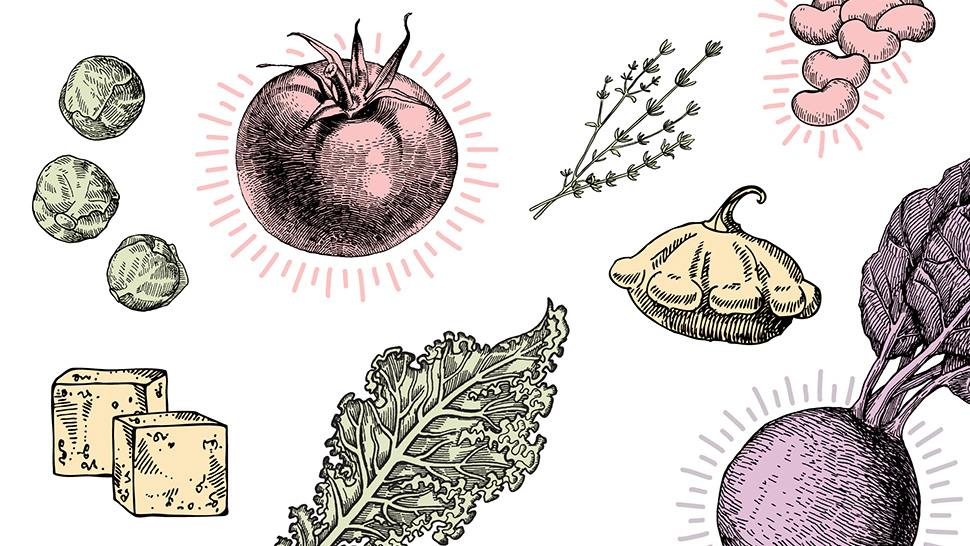
In a culture where meat often stars as the center of the meal, moving to plant-forward eating can seem like a tectonic plate shift. However, making this change doesn’t have to be as earthshaking as it seems. As many of the world’s most delicious cuisines illustrate, just a little bit of meat can go a long way when it comes to flavor. (Think of the regional foods of South and Southeast Asia, Africa, and the Mediterranean.) Best of all, by making meat the accent and plants the stars of our plates, there are material benefits for both our bodies and the Earth.
Plants offer a wealth of health
A vast and diverse body of research has consistently shown that plant foods (vegetables, fruit, whole grains, legumes, nuts and seeds) promote health. Plant foods have been shown to reduce risk of chronic diseases such as heart disease, diabetes, and cancer; boost immunity; aid weight management; and improve the aging process. Meanwhile, eating more animal products is linked to increased risk of many of the chronic diseases and conditions listed above.
Even though research has proven that consuming more vegetables promotes health, according to a Centers for Disease Control and Prevention, 87 percent of Americans do not meet the recommendation to eat 2-3 cups of vegetables per day. So, the real shift is learning to fill the plate with vegetables first, then consider creative ways to add protein, whether it’s meat, fish, or plant-based.
Need more proof that plants are powerful? Consider the findings in the following studies:
- EPIC study of 520,000 people shows those who ate a more plant-based diet lived longer. The study also showed that vegans, vegetarians, and pescatarians had the lowest BMIs.
- The Adventist Health Study II linked vegetarian diets with lower inflammation. Inflammation is tied to increased risk of heart disease and diabetes.
- Meta-analysis of 76,000 people found 24 percent lower rates of heart disease in vegetarians.
- Study finds vegetarians have 12 percent lower risk of cancer than meat eaters.
A positive impact on the planet
Eating more plants is good for human health, but is a plant-forward diet really a meaningful environmental solution? Again, the research says yes. Many aspects of the meat, egg, and dairy industries play a prominent role in climate change and may be responsible for at least 15 percent of human-caused global greenhouse gas emissions. According to a study led by a team of researchers from four American universities and published in the journal Climatic Change, if Americans switched from eating beef to eating beans, the United States would immediately realize 50 to 75 percent of its greenhouse gas emissions reduction targets for the year 2020.
It’s unlikely that America will give up all of its beef for beans, and it’s also not fair to blame beef for all animal agriculture–related impacts on the planet. According to the Environmental Defense Fund, “if every American skipped one meal of chicken per week and substituted vegetables and grains…the carbon dioxide savings would be the same as taking more than half a million cars off of U.S. roads.” Here are a few compelling facts that make a case for making meat an accent on the plate:
- The 400 gallons of water needed to raise a single egg fills a family-sized hot tub. (Source: Meatonomics, David Robinson Simon)
- The EPA found it takes 9 gallons of water to process just one chicken carcass, and chicken processing plants generate more waste water than even cattle and pig processing plants.
- Animals confined in U.S. factory farms produce three times more waste than the entire U.S. population. This manure can contaminate water supplies and emit harmful gases such as hydrogen sulfide, ammonia, and methane.
The takeaway? Even small changes to our diets can make a big difference for our health and the health of the planet. By adopting a plant-forward philosophy, even meat-eaters can reap positive benefits to their health and for the planet — without giving up meat altogether. Learn how to integrate more plant foods into your diet here and discover techniques for elevating the umami factor in plant-forward dishes here.